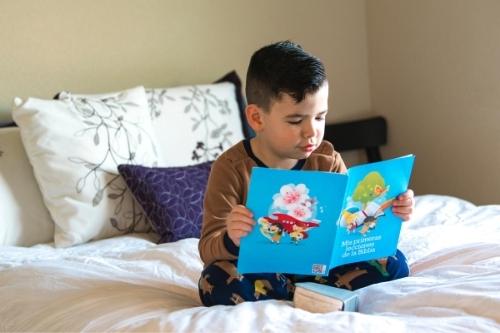The research is in: a home library for your child benefits their education. Children with home libraries are often more successful academically, have higher literacy rates, and even develop better math and technological skills (read more here). When children are young, their home library can be a quiet one-on-one time for reading together with a parent. Shared reading for as little as twenty-minutes a day increases vocabulary, attention, and even creativity (read more here). These skills contribute to higher academic success and as one study suggests, higher IQs.
To create a meaningful home library for your child, parents first need to have an honest look at their own reading habits. Parents are their child’s first role model. It’s important to observe your own entertainment habits. Are they digitally based videos or games? What are your children learning about your love of books? If parents approach reading together with their children as a chore, a child will most likely adopt that attitude as well. But, parents can modify their habits and become a role model who approaches reading with a positive attitude.
Creating Your Child’s Home Library
Children do not need a large space for a library nook. A corner with a comfy chair and a shelf will do. As they grow to adolescence, readers will put their own spin on how they want the nook to expand. Teens often post their bookshelves on social media. Their books are shelved alongside corresponding merchandise, including toys like LEGOS and POP dolls.
In their toddler years, keep your child’s board books in a basket that is easy to reach. Books should be readily available for quick entertainment, more so than screen time. As they enter preschool, add a small art table stocked with paper, markers, crayons, or pencils. Often reading or flipping through the pictures in a book can inspire a child to draw or write their own interpretation of the story.
As you continue to add to your reader’s home library, consider the strategies below to help expand their home library experience.
- Create a book swap with your child’s friends
This can be helpful for children who read quickly. - Keep your child’s favorite books
When older, they might want to revisit a story for the emotional feeling it brought when they were younger. If you have a spare room or an attic, pack up a box or two of their favorites and store them. Your children might want those beloved stories for their children one day, too. - Allow children to choose books they cannot read yet
Many nonfiction books contain dense, informative text. Young readers enjoy looking at the pictures and grow into reading the words. - Add books your child chose for themself
Children enjoy the autonomy of choosing what they want to read apart from school assignments and the attending expectations. - Add a beloved book from your childhood
This will work better with younger children and can create a personal experience in sharing your own childhood memories with them. - Create a little free library
If your child is a big reader and has amassed a huge collection of paperbacks, ask them which would be okay to give away. They may enjoy the idea of sharing the books they’ve outgrown with younger children. - Start a book club or join one
Some parents might host a monthly book club for their children, or the local library might offer a children’s book club. Book clubs introduce your child to other readers and to new genres. They also develop discussion skills. - Allow books to be left out around the house
Most of us, children and adults alike, reach for the closest form of entertainment. Nowadays it is usually a screen. Change that habit by allowing your child’s book area to be casual and allow their books to stay out in other living areas, like the couch and kitchen table. - Give books as gifts
For birthdays or holidays give your child the latest book in the series they are reading. Or choose a nonfiction book about a topic they love. - Create a book tracker
Some children will want to keep track of the titles they’ve read. Ask them if they think they’d enjoy it. Younger children can keep a journal or if they are old enough, you can look into digital reading logs where they can write reviews. Either way, tracking titles should not become a chore. Let it go if your child no longer wants to do it.
Home libraries are shown to increase academic success, but having a home library is not simply about reading; it is also about ownership and collecting. With that in mind, go easy on the child who doesn’t want to give away part of their collection to make space on their shelves. Add a shelf or box the surplus. Try to remain flexible. In addition, if there is no way additional book space can be given, alternatives might include going to the library more frequently or giving your child a designated e-reader. A home library is often a beloved, safe space for a child. Remaining aware of that and respecting the emotional aspect of the space can help as they navigate through childhood into adolescence.
About the Author

The opinions expressed in Montessori Life are those of the authors and do not necessarily represent the position of AMS. On this page |


